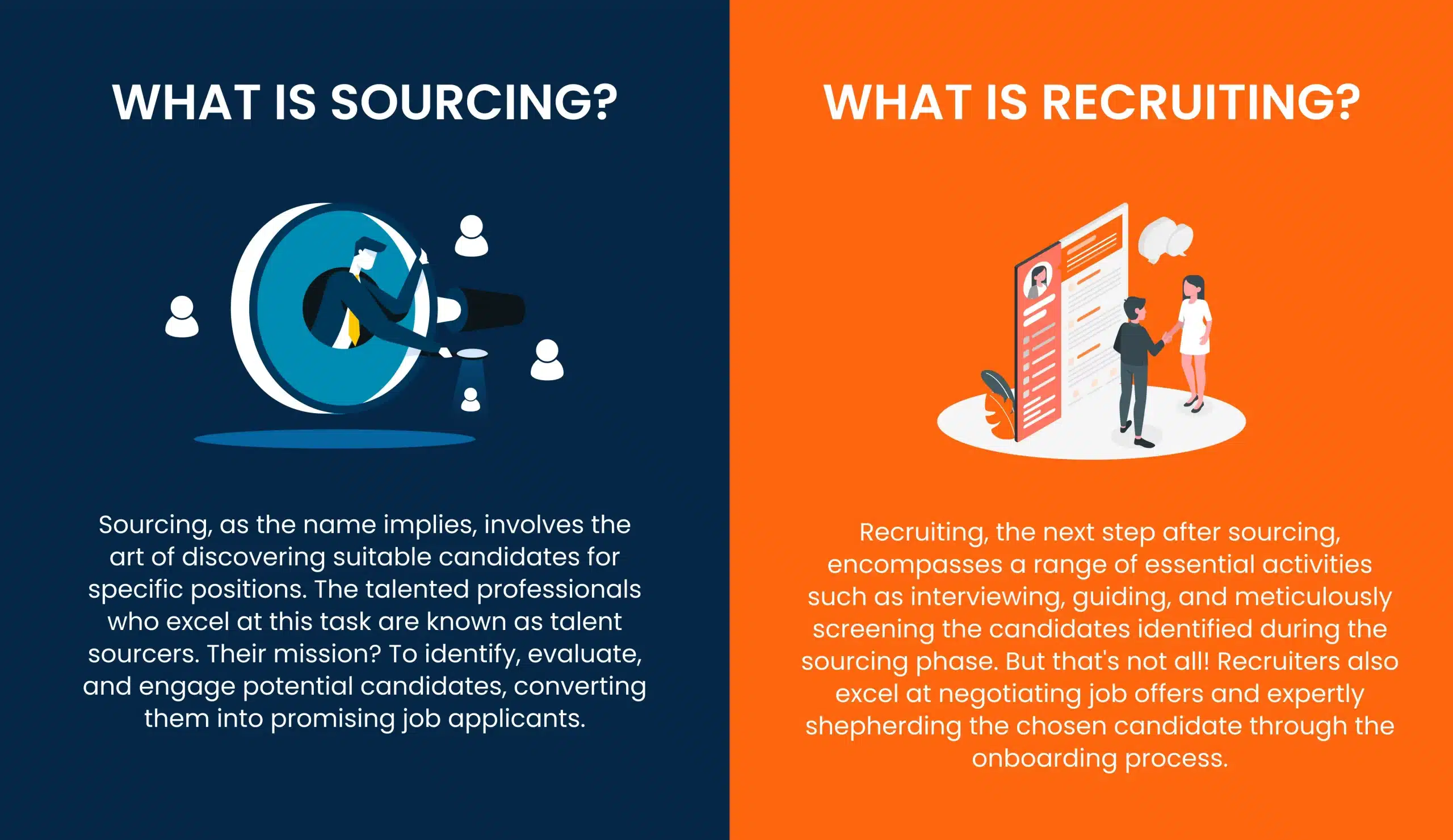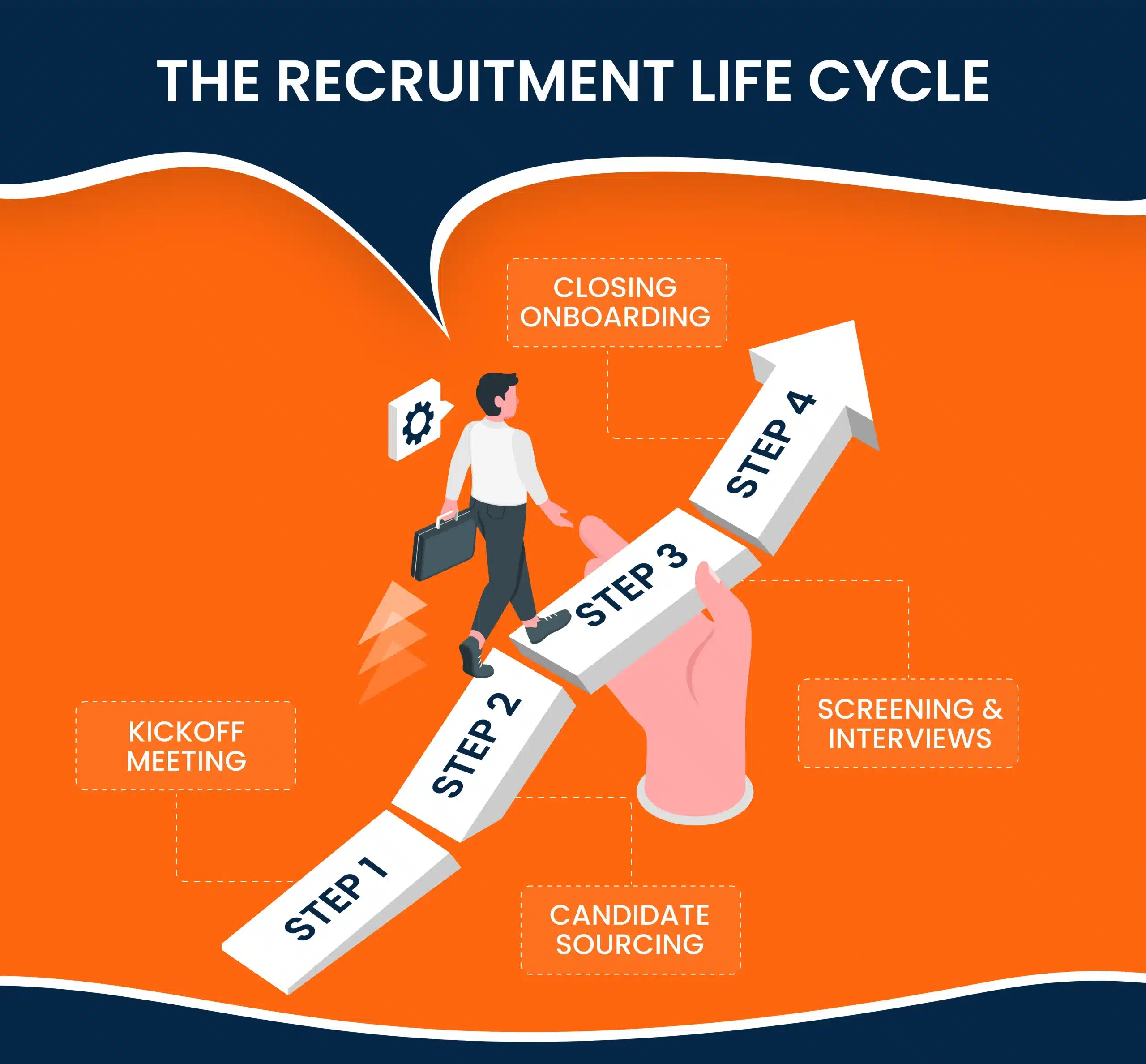Table of content
In today’s competitive job market, companies are on the hunt for top-quality talent to fill their ranks. But have you ever wondered about the roles of sourcers and recruiters in this process? While sourcing and recruiting may seem interchangeable, they play distinct and vital roles in the talent acquisition journey.
Gone are the days of traditional recruitment processes as the landscape has transformed dramatically over time. With more jobs available than ever before and a scarcity of top-level talent, organizations are constantly vying with each other to secure the best candidates. Join us as we unravel the nuances, strategies, and differences between sourcers and recruiters. Get ready to gain insights into these dynamic roles that can shape the success of any organization’s talent acquisition endeavors.
What is Sourcing?
Sourcing, as the name implies, involves the art of discovering suitable candidates for specific positions. The talented professionals who excel at this task are known as talent sourcers. Their mission? To identify, evaluate, and engage potential candidates, converting them into promising job applicants.
Talent sourcing strategies revolve around building a robust talent pipeline to meet both current and future staffing needs. Leveraging various media channels and cutting-edge technologies, sourcers entice potential candidates to express interest in open positions. The responsibilities of a skilled talent sourcer may encompass unearthing promising candidates and fostering connections, engaging passive candidates who may not be actively job hunting, generating enthusiasm for the hiring company among prospective candidates, scouring job boards and diverse platforms for talent, networking strategically to source candidates for present and future requirements.
What is Recruiting?
Recruiting, the next step after sourcing, encompasses a range of essential activities such as interviewing, guiding, and meticulously screening the candidates identified during the sourcing phase. But that’s not all! Recruiters also excel at negotiating job offers and expertly shepherding the chosen candidate through the onboarding process.
A recruiter’s list of responsibilities is as diverse as it is crucial. It includes thoroughly screening job candidates to identify the best fit, efficiently scheduling and coordinating interviews to assess candidate suitability, navigating candidates through the rigorous evaluation process, skillfully negotiating job offers to secure top talent, coordinating and maintaining open lines of communication regarding the job offer, and managing comprehensive candidate databases and deftly handling advanced ATS tools.
Sourcer vs Recruiter- The Major Differences
While sourcers and recruiters share certain job responsibilities, there are key distinctions between the two roles. Sourcers primarily focus on the initial stages of talent acquisition, conducting searches to find potential candidates.
On the other hand, recruiters handle the broader recruitment process, which includes interviewing, evaluating, and guiding candidates toward job offers. While these terms are related, they are not interchangeable, highlighting the importance of understanding their unique contributions to successful talent acquisition.
The Search
The recruitment journey kicks off with a crucial step—the recruitment intake meeting. This is where the recruiter meets with the hiring manager to truly understand the position. In some cases, the sourcer might join as well. They work together to gather all the necessary information to kickstart the sourcing process.
Once the recruiter has a clear picture of what kind of candidate they’re searching for, it’s time for sourcing to begin. This is the exciting phase where they use various techniques like X-Ray searches and Boolean searching to find potential candidates, even those who may not be actively looking for a job. Some sourcers stop here, but nowadays, most continue to the next step, ready for more action.
Interviews & Screening
Once the sourcing phase is complete, it’s time for an important step: candidate engagement. This is where sourcers step in to qualify the candidates through short phone screens or interviews. During these conversations, they gather crucial details like salary expectations and technical qualifications. It’s a crucial stage that sets the foundation for the candidate’s journey.
After the initial screening, the sourcer passes the baton to the recruiter, who takes over the candidate relationship. From this point forward, the recruiter becomes the main point of contact. They handle the ongoing communication and coordination, making sure the candidate feels supported throughout the process. While some sourcers may occasionally join meetings with the hiring manager, it’s not a common practice.
Armed with the valuable insights gathered during the sourcer’s interactions, the recruiter then presents the candidates to the hiring manager. The recruiter takes the lead in managing the candidate relationship moving forward.
Now, depending on the company’s procedures, the hiring manager may choose to interview the candidate alone or alongside the recruiter. It varies from organization to organization.
Post Hiring
This is where skilled recruiters truly shine! They play a pivotal role in facilitating the job offer process and expertly managing negotiations with both the candidate and the hiring manager.
Once the candidate has been successfully hired, they transition into the onboarding stage, typically overseen by HR or Learning and Development professionals. On the other hand, sourcers excel at attracting passive candidates who may be difficult to find and initiate the initial relationship with them. In today’s highly competitive talent market, sourcing plays a crucial role in streamlining the recruitment process and reaching candidates who may not have come across your job posting otherwise.
By sourcing passive candidates, recruiters expand the candidate pool exponentially, increasing the chances of finding the perfect fit. Essentially, recruiters take charge of every step after the candidate presentation, ensuring clear communication and alignment among all parties involved.
Moreover, recruiters also handle various administrative tasks, such as crafting an enticing job description (one that truly stands out), and strategically posting the job across relevant platforms like the company website, LinkedIn, and job boards. They coordinate interviews, conduct background checks, and skillfully draft job offers.
Wrapping Up!
In conclusion, it is evident that sourcers and recruiters play distinct yet complementary roles in the talent acquisition journey. By recognizing the value of segregating these responsibilities, organizations can enhance the effectiveness and efficiency of their talent acquisition process. The dedicated focus of sourcers on sourcing and identifying top-quality candidates, combined with the expertise of recruiters in managing the recruitment process, leads to a more targeted and successful talent acquisition strategy.
However, we understand that talent acquisition can still be a time-consuming endeavor for many organizations. That’s where Supersourcing comes into play. With an AI-powered hiring platform that features a pool of highly vetted developers, Supersourcing simplifies the entire talent acquisition process from sourcing to onboarding. By leveraging advanced technology and industry expertise, Supersourcing ensures a seamless and hassle-free experience, allowing you to focus on other critical aspects of your business.
So, if you’re looking to optimize your talent acquisition efforts and access top-tier developers, Supersourcing is your ultimate solution. Let us handle the intricacies of sourcing and recruiting while you reap the benefits of a streamlined and successful hiring process.


